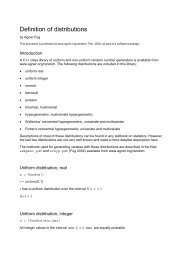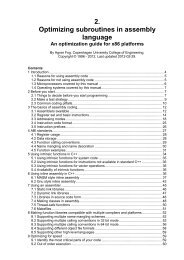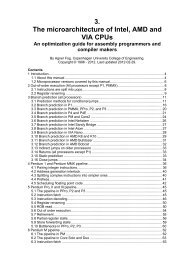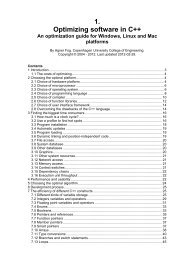4 Instruction tables - Agner Fog
4 Instruction tables - Agner Fog
4 Instruction tables - Agner Fog
You also want an ePaper? Increase the reach of your titles
YUMPU automatically turns print PDFs into web optimized ePapers that Google loves.
Bulldozer<br />
AMD Bulldozer<br />
List of instruction timings and macro-operation breakdown<br />
Explanation of column headings:<br />
<strong>Instruction</strong>:<br />
<strong>Instruction</strong> name. cc means any condition code. For example, Jcc can be JB, JNE,<br />
etc.<br />
Operands:<br />
i = immediate constant, r = any register, r32 = 32-bit register, etc., mm = 64 bit<br />
mmx register, x = 128 bit xmm register, y = 256 bit ymm register, m = any memory<br />
operand including indirect operands, m64 means 64-bit memory operand, etc.<br />
Ops:<br />
Latency:<br />
Reciprocal throughput:<br />
Execution pipe:<br />
Domain:<br />
Number of macro-operations issued from instruction decoder to schedulers. <strong>Instruction</strong>s<br />
with more than 2 macro-operations use microcode.<br />
This is the delay that the instruction generates in a dependency chain. The numbers<br />
are minimum values. Cache misses, misalignment, and exceptions may increase<br />
the clock counts considerably. Floating point operands are presumed to be<br />
normal numbers. Denormal numbers, NAN's, infinity and exceptions increase the<br />
delays. The latency listed does not include the memory operand where the listing<br />
for register and memory operand are joined (r/m).<br />
This is also called issue latency. This value indicates the average number of clock<br />
cycles from the execution of an instruction begins to a subsequent independent<br />
instruction of the same kind can begin to execute. A value of 1/3 indicates that the<br />
execution units can handle 3 instructions per clock cycle in one thread. However,<br />
the throughput may be limited by other bottlenecks in the pipeline.<br />
Indicates which execution pipe or unit is used for the macro-operations:<br />
Integer pipes:<br />
EX0: integer ALU, division<br />
EX1: integer ALU, multiplication, jump<br />
EX01: can use either EX0 or EX1<br />
AG01: address generation unit 0 or 1<br />
Floating point and vector pipes:<br />
P0: floating point add, mul, div, convert, shuffle, shift<br />
P1: floating point add, mul, div, shuffle, shift<br />
P2: move, integer add, boolean<br />
P3: move, integer add, boolean, store<br />
P01: can use either P0 or P1<br />
P23: can use either P2 or P3<br />
Two macro-operations can execute simultaneously if they go to different<br />
execution pipes<br />
Tells which execution unit domain is used:<br />
ivec: integer vector execution unit.<br />
fp: floating point execution unit.<br />
fma: floating point multiply/add subunit.<br />
inherit: the output operand inherits the domain of the input operand.<br />
ivec/fma means the input goes to the ivec domain and the output comes from the<br />
fma domain.<br />
There is an additional latency of 1 clock cycle if the output of an ivec instruction<br />
goes to the input of a fp or fma instruction, and when the output of a fp or fma instruction<br />
goes to the input of an ivec or store instruction. There is no latency<br />
between the fp and fma units. All other latencies after memory load and before<br />
memory store instructions are included in the latency counts.<br />
An fma instruction has a latency of 5 if the output goes to another fma instruction,<br />
6 if the output goes to an fp instuction, and 6+1 if the output goes to an ivec or<br />
store instruction.<br />
Page 36






